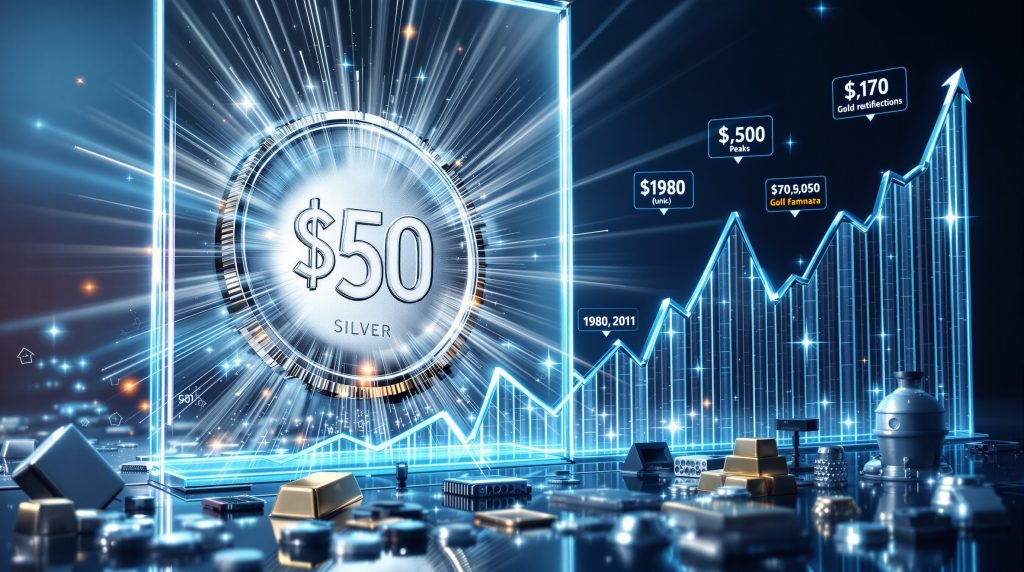What Makes $50 Silver So Significant?
The Historical Context of the $50 Threshold
Silver has only approached or briefly surpassed the $50 mark twice in modern financial history. The first instance occurred in January 1980 during the Hunt Brothers' infamous attempt to corner the silver market, when prices briefly touched the $50 level before collapsing. The second approach came in April 2011 during the post-financial crisis commodities boom, when silver reached approximately $49.45 before reversing sharply downward.
This price level represents both a psychological and technical barrier that has contained silver for over four decades, making a sustained break above $50 potentially transformative for the precious metals market and investor sentiment. The silver market squeeze analysis suggests that current conditions may create a more sustainable foundation for prices to finally break through this historic ceiling.
Psychological Impact on Market Participants
The $50 threshold functions as a powerful psychological anchor for investors, traders, and industrial users alike. Market psychology often shifts dramatically once long-standing resistance levels are breached, especially ones with historical significance spanning multiple generations of traders.
A decisive move above $50 would likely trigger significant media attention and broader market recognition, potentially drawing new participants into the silver market who had previously remained on the sidelines. This influx of new investment could create a self-reinforcing cycle as increased participation drives further price appreciation.
Unlike previous approaches to this level, today's fundamentals suggest a more sustainable foundation for higher prices, with structural supply deficits replacing the speculative excesses that characterized prior peaks.
Why Is Silver Approaching $50 in 2025?
Fundamental Supply-Demand Imbalance
The current trajectory toward $50 silver is underpinned by persistent supply constraints meeting rising demand across multiple sectors. According to data from The Silver Institute's World Silver Survey, global silver mine production was approximately 843.2 million ounces in 2022, with total supply (including recycling) reaching around 1.03 billion ounces.
This supply framework faces increasing pressure from growing industrial applications that now represent over 50% of annual demand, creating a fundamental imbalance that distinguishes the current rally from previous price spikes that were predominantly investment-driven. Furthermore, the potential silver tariffs impact could create additional price pressure as global trade policies evolve.
Industrial Demand Acceleration
The green energy transition has dramatically increased industrial silver consumption across multiple sectors:
- Solar panel manufacturing: Photovoltaic installations continue to accelerate globally, with each gigawatt of solar capacity requiring approximately 80,000 ounces of silver
- Electric vehicle production: Each EV contains significantly more silver than traditional vehicles, primarily in battery connections, electrical control systems, and solar roof applications
- 5G infrastructure: Advanced telecommunications equipment requires silver for its superior conductivity properties
- Medical applications: Silver's antimicrobial properties have expanded its use in healthcare settings, especially following global health concerns
This diverse industrial demand base provides a solid foundation for higher prices that previous rallies lacked, as silver becomes increasingly recognized as both a precious and industrial metal.
Investment Flows Shifting from Traditional Assets
Professional investors and institutions have begun reallocating capital from traditional investment vehicles toward precious metals as portfolio diversifiers. This trend represents a significant shift in capital allocation patterns that has accelerated in recent years.
The outperformance of silver against the conventional 60/40 portfolio (60% stocks, 40% bonds) has reached multi-year highs, indicating substantial reallocation of institutional capital. As more investors recognize this relative strength, additional capital flows may follow, providing sustained upward pressure on prices.
What Happens When Silver Breaks $50?
Technical Price Projections
Technical analysis suggests several potential price targets once silver breaks decisively above the $50 psychological barrier:
| Price Target | Technical Basis | Timeframe Projection |
|---|---|---|
| $53-55 | Initial momentum target | 1-2 weeks after breakout |
| $60-65 | Cup and handle formation | 2-3 months after breakout |
| $75-80 | Long-term base projection | 6-12 months after breakout |
| $100+ | Historical analog (1970s) | 12-24 months after breakout |
Historical chart patterns suggest that once silver clears the $50 level, the path to significantly higher prices could accelerate rapidly. The formation of a cup-and-handle pattern just below the $50 level mimics the technical structure seen before the dramatic 1970s silver rally, suggesting similar potential for sharp gains once this multi-decade resistance is overcome.
Potential for Increased Volatility
Historical precedent suggests that once silver breaks major resistance levels, price volatility typically increases significantly. Daily price swings of 3-5% could become commonplace, with potential for both sharp advances and equally sharp corrections.
Previous silver bull markets have demonstrated that even during strong uptrends, periodic corrections of 15-25% are normal and help establish sustainable foundations for the next advance. These volatility patterns make risk management particularly crucial during breakout phases, especially for leveraged positions or options strategies.
Investors should be prepared for potential failed breakout attempts initially, as these often precede sustainable moves higher. The transition through such a significant threshold rarely occurs smoothly, and patient positioning is typically rewarded over aggressive trading around these key levels.
How Will Mining Stocks Respond to $50+ Silver?
Leverage Effect on Silver Mining Equities
Silver mining stocks typically demonstrate significant leverage to the underlying metal price due to their operational structures and fixed cost bases. This leverage effect becomes more pronounced at higher silver prices as profit margins expand disproportionately.
Historical performance patterns indicate that a 10% move in silver often translates to a 15-25% move in major producers and potentially 30-50% in junior miners. This amplified price response results from the expanding profit margins as silver prices move significantly above production costs.
The most pronounced leverage typically occurs in companies with:
- Higher operational costs (but still profitable)
- Significant exploration or development assets
- Pure silver exposure rather than diversified production
- Fixed debt obligations that become proportionally smaller at higher prices
Valuation Metrics at $50+ Silver
At $50+ silver, producer economics transform dramatically as marginal operations become highly profitable and established producers generate exceptional cash flow:
| Metric | At $25 Silver | At $50 Silver | At $75 Silver |
|---|---|---|---|
| Average AISC | $18-22/oz | $20-24/oz | $22-26/oz |
| Profit Margin | $3-7/oz | $26-30/oz | $49-53/oz |
| Free Cash Flow Yield | 3-5% | 12-18% | 25-35% |
| P/NAV Valuation | 0.7-0.9x | 1.2-1.5x | 1.8-2.2x |
This expanding margin profile creates potential for significant revaluation of silver mining equities. While production costs typically increase somewhat at higher silver prices (due to royalty structures, profit-sharing agreements, and industry-wide cost inflation), these increases are generally modest compared to revenue growth.
Junior Miner Development Economics
For development-stage silver projects, the economics at $50+ silver transform marginal deposits into highly profitable opportunities:
- Projects with 30+ million ounce resources become economically viable at much lower grades
- Internal Rate of Return (IRR) projections often exceed 50% at $50 silver
- Financing becomes readily available for previously marginal projects
- Merger and acquisition activity typically accelerates as major producers seek to replenish reserves
The junior mining sector in particular often experiences dramatic revaluation during sustained silver bull markets. Companies with quality management teams and defined resources in favorable jurisdictions typically outperform, especially when their projects become economically viable at higher price levels.
What Are the Warning Signs of a Silver Price Peak?
Technical Indicators of Overextension
Several technical indicators typically flash warning signs before major corrections in silver:
- RSI readings above 85 on daily charts and above 80 on weekly charts
- Silver outperforming gold by more than 15% over a 20-day period
- New 52-week highs in silver mining stocks exceeding 70% of components
- Silver/S&P 500 ratio reaching extreme deviation from its 200-day moving average
Historical analysis shows that when these technical indicators reach extreme levels simultaneously, the probability of at least a temporary correction increases significantly. Currently, the percentage of components in silver mining indexes making new 52-week highs has approached levels that preceded previous intermediate-term peaks.
Sentiment and Positioning Extremes
Market sentiment indicators that often signal approaching corrections include:
- Bullish consensus among silver analysts exceeding 90%
- Speculative long positions in silver futures reaching 3x their 5-year average
- Put/call ratios on silver ETFs dropping below 0.3
- Retail investment demand for physical silver coins and bars creating 4+ week delivery delays
Extreme sentiment readings typically coincide with periods when media coverage of silver dramatically increases, often featuring headlines about price targets significantly above current levels. These conditions frequently emerge near intermediate-term tops and represent potential warning signs for prudent investors.
Historical Correction Patterns
Silver has historically experienced significant corrections even during strong bull markets:
| Bull Market Period | Peak-to-Trough Corrections |
|---|---|
| 1971-1974 | Three corrections of 15-28% |
| 1976-1980 | Two corrections of 22% and 33% |
| 2009-2011 | Four corrections of 13-25% |
| 2020-Present | Three corrections of 11-19% to date |
These historical patterns suggest investors should prepare for similar volatility even as the long-term trend remains higher. The silver market crash recovery dynamics indicate that corrections often provide opportunities to accumulate positions at more favorable prices and typically occur when sentiment becomes excessively bullish.
How Does Silver at $50 Compare to Gold's Performance?
Gold-Silver Ratio Analysis
The gold-silver ratio (GSR) provides important context for silver's potential at $50. This ratio, which measures how many ounces of silver it takes to buy one ounce of gold, has historically ranged from approximately 15:1 to over 100:1, with long-term averages around 60-70:1.
During precious metals bull markets, the ratio typically compresses as silver outperforms gold in percentage terms. Historically, the most significant silver price advances have occurred during periods when the gold-silver ratio was declining rapidly:
| Historical Period | Starting GSR | Ending GSR | Silver Performance |
|---|---|---|---|
| 1971-1974 | 78:1 | 29:1 | +477% |
| 1976-1980 | 50:1 | 16:1 | +933% |
| 2008-2011 | 84:1 | 31:1 | +448% |
| 2020-Present | 124:1 | ~80:1 | +100% |
This historical tendency for ratio compression during bull markets suggests additional upside potential for silver relative to gold, especially if the current ratio moves toward its long-term average or below. Recent gold-silver ratio insights provide important context for investors attempting to time optimal entry points.
Relative Performance Cycles
Silver and gold typically move through distinct relative performance cycles within broader precious metals bull markets:
- Initial phase: Gold leads, silver lags (capital prioritizes stability)
- Middle phase: Silver catches up, begins to outperform (risk appetite increases)
- Final phase: Silver dramatically outperforms (speculative interest peaks)
Tracking the gold-silver ratio helps identify transitions between these phases. Periods of rapid ratio compression (silver outperforming) often align with the most dramatic price advances for both metals, though silver typically experiences higher percentage gains and higher volatility.
Historical analysis indicates that silver's most explosive moves frequently occur after gold has already established a strong uptrend and broken to new highs, creating the confidence necessary for investors to move further out on the risk spectrum.
What Are the Investment Implications of $50+ Silver?
Portfolio Allocation Considerations
As silver approaches and potentially exceeds $50, portfolio allocation strategies may need adjustment:
- Consider trimming positions that have grown outsized due to appreciation
- Maintain core physical holdings while potentially shifting some allocation to mining equities for additional leverage
- Implement trailing stop strategies to protect gains while maintaining upside exposure
- Consider options strategies to hedge against increased volatility
For long-term investors, maintaining a strategic allocation to silver remains prudent even at higher price levels, particularly given the metal's dual role as both an industrial commodity and monetary asset. However, tactical adjustments may be warranted when technical or sentiment indicators suggest potential correction periods.
Risk Management Strategies
Prudent risk management becomes increasingly important at elevated price levels:
- Position sizing should account for silver's historical volatility
- Diversification across physical metal, major producers, and select juniors reduces company-specific risk
- Regular portfolio rebalancing prevents overconcentration as prices rise
- Maintain liquid reserves to take advantage of sharp corrections
Investors who have experienced significant gains may consider implementing a core-and-satellite approach, maintaining a permanent strategic allocation while adjusting tactical positions based on market conditions and technical indicators. Effective silver squeeze strategies can help investors navigate volatile price movements during breakout periods.
How Might $50+ Silver Impact the Broader Economy?
Industrial User Adaptation
Industries heavily dependent on silver will face increased input costs, potentially leading to:
- Thrifting (reducing silver content in products where possible)
- Increased recycling efforts to recover silver from electronic waste
- Price increases passed to consumers for silver-intensive products
- Long-term supply contracts to secure stable pricing
Electronics manufacturers, solar panel producers, and other industrial users typically respond to higher prices through a combination of these approaches. However, in many applications, silver's unique properties make substitution difficult or impossible, limiting the potential for thrifting in critical components.
Solar panel manufacturers, who currently represent one of the largest industrial demand segments for silver, have already reduced silver content per panel by approximately 30% over the past decade. Further reductions may be limited by efficiency considerations, especially as the industry shifts toward higher-efficiency panel designs.
Investment Market Ripple Effects
Silver breaking $50 could create broader market effects:
- Increased correlation between precious metals and inflation expectations
- Potential pressure on central banks to address monetary policy
- Heightened interest in commodity-focused investment strategies
- Possible rotation from growth to value/tangible asset investments
The psychological impact of a major precious metal breaking through long-term resistance could influence investor perceptions about monetary stability and inflation risks, potentially triggering allocation shifts across multiple asset classes.
What's Driving Silver's Current Rally Toward $50?
Monetary and Inflation Factors
Several monetary conditions support silver's current trajectory:
- Real interest rates remain historically low despite nominal rate increases
- Central bank balance sheets remain significantly expanded compared to pre-2020 levels
- Inflation expectations have become more entrenched in many economies
- Currency debasement concerns persist among institutional investors
Silver has historically performed strongly during periods of negative real interest rates (when inflation exceeds nominal interest rates). This monetary environment creates incentives for investors to seek assets with inflation-protection characteristics, benefiting precious metals broadly.
Supply Constraints in Silver Production
Silver supply faces significant constraints that support higher prices:
- Primary silver mines represent only 25-30% of global production
- The majority comes as a byproduct of base metal mining, limiting supply elasticity
- Development timelines for new mines typically exceed 5-7 years
- Environmental permitting has become increasingly restrictive for new mining projects
This supply structure creates inelasticity in production response to higher prices. Unlike many commodities, silver production cannot be quickly ramped up when prices rise, as the majority comes as a byproduct of other mining operations. This dynamic can exacerbate price moves during periods of strong demand.
The capital-intensive nature of mining and extended development timeframes create significant lag between price signals and production responses. Even at substantially higher prices, new mine development typically requires 5-10 years from discovery to production, creating potential for extended periods of supply deficit.
FAQs About Silver Breaking $50
Will silver stay above $50 once it breaks that level?
Historical precedent suggests initial tests of major resistance levels often see failed breakouts before sustained moves higher. Investors should be prepared for potential volatility and even brief drops back below $50 before a sustained move higher establishes itself.
The first successful close above $50 will likely be followed by tests of that level as support. The strength of these tests and the market's reaction to them will provide important technical information about the sustainability of the breakout.
How does silver at $50 compare to its inflation-adjusted all-time high?
The inflation-adjusted all-time high for silver (from January 1980) would be approximately $150-175 in today's dollars, suggesting significant potential upside remains even after breaking $50.
This comparison highlights that even at $50, silver would remain well below its inflation-adjusted peak, unlike gold which has already surpassed its inflation-adjusted 1980 high. This divergence suggests potential for ratio compression and silver outperformance in a continued precious metals bull market.
Could government intervention affect silver if it breaks above $50?
Unlike gold, which has historical precedent for government price controls, silver has rarely faced direct intervention. However, increased margin requirements on futures contracts or changes to ETF regulations could temporarily impact price momentum.
The diverse industrial applications for silver make outright restrictions less likely than for purely monetary metals. However, regulatory changes affecting investment vehicles or derivatives markets remain possible, especially if volatility increases dramatically.
How might $50+ silver affect solar panel and electric vehicle production costs?
While silver represents a relatively small percentage of total production costs for these items (typically 2-5%), sustained high prices could accelerate research into silver alternatives or more efficient application methods.
For solar panels, silver represents approximately $0.15-0.20 per watt at $25/oz silver prices. At $50/oz, this cost component would roughly double but would remain a manageable portion of overall panel costs, which have declined significantly in other areas.
Conclusion: Preparing for a New Silver Paradigm
The potential break above $50 represents more than just another price milestone—it signals a fundamental revaluation of silver's role in both industrial and investment portfolios. Unlike previous approaches to this level, today's move is supported by structural supply deficits, accelerating industrial demand, and shifting investment flows.
Investors should prepare for increased volatility, maintain disciplined position sizing, and recognize that even in strong bull markets, corrections of 15-25% are normal and healthy. The most successful approach will likely involve maintaining core positions while tactically adjusting exposure as technical and sentiment indicators warrant.
As silver approaches this historic threshold, both the risks and opportunities are magnified, requiring a balanced approach that respects silver's historical volatility while positioning for its potential in a changing global economic landscape.
Disclaimer:
The analysis presented in this article is based on historical data and current market conditions. Future price movements involve uncertainty, and investors should conduct their own due diligence before making investment decisions. Past performance is not indicative of future results.
Ready to Capitalise on the Next Major Mining Discovery?
Discover why significant mineral announcements can lead to exceptional market returns by exploring Discovery Alert's dedicated discoveries page, where the proprietary Discovery IQ model turns complex ASX mineral data into actionable investment insights before the broader market reacts.




